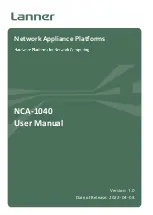
TSP-EAS-1 User Manual
Version 1.6 5/10/2017
Page 9 of 30
OK
ERR
OK
ERR
CVBS
Note:
1)
The “ASIIN” in
Error! Reference source not found.
shows the status of the ASI input. If no TS is
etected and locked in the ASI input, the status shows “N/A”, if TS is detected and locked in the ASI
input, the status will alternate between the TS actual rate(Mb/s) and the number of programs in the TS.
2)
The “ASIOUT” in
Error! Reference source not found.
3 shows the status of the ASI output. If no TS
s present in the ASI output, the status shows “N/A”, if TS is present in the ASI output, the status will
alternate between the TS’s payload rate(Mb/s) and the number of programs in the TS.
3)
The “PSIP” in Table 3 shows where the PSIP data comes from, “Static” means using the MUX’s built
in static PSIP, “Dynamic” means PSIP data comes from the Dynamic PSIP module, “Disable” means
PSIP insertion is disabled. “STATUS” only takes effect when the PSIP data source is “Dynamic”, “OK”
means the PSIP data is detected and inserted by MUX, “ERR” means no PSIP data detected
The "CVBS" status in
Table 4 indicates if the composite video signal is detected at the corresponding CVBS input. “OK”
means signal detected, “ERR” means no signal detected.
The "SDIIN" status in
Table 45 indicates if signal is detected at the corresponding SDI input. “OK” means signal detected,
“ERR” means no signal detected.
6)
The “SDIOUT” status in Table 6 indicates if the particular SDI output is active. “OK” means active,
“ERR” means inactive
7)
The “SOURCE” in Table 6 shows where the SDI output signal source comes from, “CVBS” means it’s
converted from CVBS input, “SDI” means it’s from SDI input, “EAS” means it’s from EAS signal










































